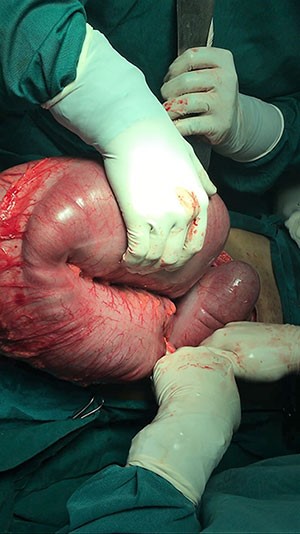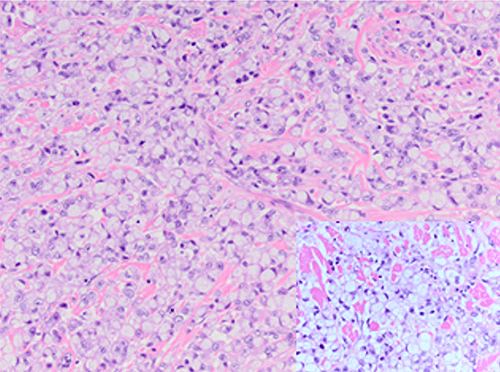Discussion
Visceral artery pseudoaneurysms present most commonly with abdominal pain, but they may also present with hypotension, back pain, jaundice, vomiting, gastric outlet obstruction, diarrhea, melena or hematochezia. The presentation is often dependent on the vessel location of the pseudoaneurysm and the route or location of a free rupture (if present). Hematomas within the lumen of the gastrointestinal tract, peritoneal cavity or retroperitoneum may account for such diverse symptomotology.5,6,7 Visceral artery pseudoaneurysms may be diagnosed by ultrasound, CT or visceral angiography with sensitivities of 50%, 67% and 100%, respectively.6 Since visceral artery pseudoaneurysms can undergo free rupture and result in hemodynamic instability, emergent treatment may be necessary.3,4 There is no correlation between pseudoaneurysm size and risk for free rupture.2,5
Pseudoaneurysms of the gastroduodenal, or related pancreaticoduodenal arcade vessels, are extremely rare. They comprise roughly 5% of all visceral artery pseudoaneurysms.2,6 Most commonly, these abnormalities arise secondary to pancreatic inflammation related to chronic pancreatitis.2,6 Two-thirds of gastroduodenal artery pseudoaneurysms are diagnosed before free rupture occurs.6 The mortality rate of treated gastroduodenal artery pseudoaneurysms that have not undergone free rupture is 15%. However, the mortality rate reaches 50% when free rupture has occurred.4,6,8 Free rupture of pseudoaneurysms at these sites commonly occur into the bowel lumen (50% of cases) or peritoneal cavity.4,6,8 Consequently, they often present with gastrointestinal bleeding in the form of melena, hematochezia or hematemesis.sup>6,7,8 Gastroduodenal artery pseudoaneurysms presenting with rupture are emergencies in need of aggressive, early management due to the tendency to cause life-threatening hemorrhage, with associated hypotension and shock.6,7,8 When the pseudoaneurysm is localized more distally, in the pancreaticoduodenal artery arcade (as opposed to the gastroduodenal artery), the rate of rupture is 50–90%.2 However, free rupture of the distal branches is usually retroperitoneal, contained and less commonly fatal.2,6
In the literature, there have been four reported cases of gastroduodenal/pancreaticoduodenal artery pseudoaneurysm rupture, and additional retrospective studies mention ten others. The case reports included three men and one woman with ages ranging from 35 to 56 years. A 56-year-old woman presented with hypotension, had a pseudoaneurysm diagnosed by angiography, and was successfully treated with trans-arterial embolization.2 A 54-year-old man presented with hypertension, later became hypotensive, had a pseudoaneurysm diagnosed by three-dimensional CT, underwent an unsuccessful embolization and expired as a result of the rupture.7 A 35-year-old man with chronic pancreatitis had a pseudoaneurysm diagnosed by CT. The pseudoaneurysm was treated with surgical ligation because the hospital did not have interventional endovascular capabilities.8 A 40-year-old man with acute pancreatitis and hemophilia A had a pseudoaneurysm diagnosed by CT and expired secondary to hematemesis before treatment.9
The pseudoaneurysms in the retrospective study were all visualized under angiography in patients with history of pancreatitis or prior pancreatic surgery.5 Out of the ten patients in the retrospective study, nine of them underwent successful embolization.5 The remaining patient’s embolization failed due to intra-procedural rupture necessitating successful stent graft placement.5
The initial determination of treatment approach for patients with visceral artery pseudoaneurysms should be based largely on their hemodynamic status. Hemodynamically stable patients should undergo angiography with therapeutic embolization if possible. Surgical management may be considered for hemodynamically unstable patients, those with failed embolization, or when angiographic capabilities are not available.5
Embolization can be achieved with coils, particulate materials such as polyvinyl alcohol or gel foam, N-acetyl cyanoacrylate or a combination of these agents.5,11 Technical success is considered when perfusion of the pseudoaneurysm ceases no contrast extravasation is visulized.5,11 As an alternative to embolization, a stent graft may be deployed across the abnormal vessel to allow distal organ perfusion, while excluding the pseudoaneurysm from circulation.5 Stents cannot be used if there is not sufficient vessel length on either side of the pseudoaneurysm, if there is significant vessel tortuosity, or a correctly sized stent graft is not available.10
The technical success rates of endovascular intervention in two different studies ranged from 98–100%.5,10,8 Interestingly, there was no correlation between overall survival and the success of the embolization performed, although the sample sizes of the studies are small.5 In contrast, only low numbers of blood transfusion products needed prior to angiography are associated with better survival.5 Complications of embolization include end-organ infarction, post-embolization syndrome, re-bleeding and reperfusion of the pseudoaneurysm.10,11 Contraindications to endovascular intervention include the need to maintain patency of the feeding vessel or the presence of collaterals near or arising from the pseudoaneurysm. In these instances, a stent graft or surgical intervention may be needed.10
Surgical intervention includes pseudoaneurysm resection with revascularization, or pseudoaneurysm ligation with or without end organ resection.10,11 Postoperative morbidity and mortality is higher in patients treated with surgery, making endovascular approaches more appealing when possible.5
Conclusion
Herein, we describe a classic example of a retroperitoneal bleed from a pancreaticoduodenal artery pseudoaneurysm and associated free rupture. The patient was hemodynamically stable throughout. His pseudoaneurysm was most likely related to acute on chronic pancreatitis in a patient with a history of alcoholism. The abnormality was diagnosed by CT angiography, and treated successfully by trans-arterial embolization.
Trans-arterial embolization is the standard of care for treatment of visceral artery pseudoaneurysms. The technique is precise, successful, and has a low complication rate.4,5 Surgical intervention is a more invasive option, and generally reserved for patients with hemodynamic instability, where embolization is unsuccessful or not available.5,7,8
Lessons Learned
Gastroduodenal artery/pancreaticoduodenal artery pseudoaneurysms are rare forms of visceral artery pseudoaneurysms. When they occur more proximally in the gastroduodenal artery, they are more likely to be diagnosed before free rupture, but they carry high mortality due to hemorrhage and hemodynamic instability if they do undergo free rupture. Those of the more distal pancreaticoduodenal artery are more likely to be diagnosed after rupture but the bleeds are typically contained within the retroperitoneum and almost always survivable. This case highlights ta visceral artery pseudoaneurysm, which should be considered in the differential diagnosis of abdominal pain and associated symptoms, especially in patients at risk for chronic pancreatitis. Diagnosis is effectively made by CT angiography, and successful management is achieved by trans-arterial embolization.
Abbreviations
Carcinoembryonic antigen (CEA) and cancer antigen 19-9 (CA 19-9) are tumor markers used in pancreatic cancer patients.
Authors
Sarah M. Kling, MD
Department of Surgery
Thomas Jefferson University
Jordan Winter, MD, FACS
Department of Surgery
Thomas Jefferson University
Correspondence
Dr. Jordan Winter
Department of Surgery
Thomas Jefferson University
1025 Walnut Street
College Building, Suite 611
Philadelphia, PA 19107
Phone: 215-955-1171
E-mail: jordan.winter@jefferson.edu
Disclosures
There are no conflicts of interest and no source of funding.
References
- Cronenwett, J. L., Johnston, K. W. Rutherford’s Vascular Surgery. Philadelphia, PA: Saunders. 2010:7th ed.
- Dallara, H., & Habboushe, J. Spontaneous inferior pancreaticoduodenal artery pseudoaneurysm rupture. Intern Emerg Med. 2017;12(8):1319-1321.
- Pitton, M.B., Dappa, E., Jungmann, F., Kloeckner, R., et. al. Visceral artery aneurysms: Incidence, management, and outcome analysis in a tertiary care center over one decade. Eur Radiol. 2015;25(7):2004-2014.
- Carr, S.C., Pearce, W.H., Vogelzang, R.L., McCarthy, W.J., Nemcek, A.A., & Yao, J.S. Current management of visceral artery aneurysms. Surg. 1996;120(4):627-634.
- Kalva, S.P., Yeddula, K., Wicky, S., Castillo, C.F., & Warshaw, A.L. Angiographic Intervention in Patients With a Suspected Visceral Artery Pseudoaneurysm Complicating Pancreatitis and Pancreatic Surgery. Arch Surg. 2011;146(6):647-652.
- Hu, K., Chang, W., Chu, C., Wang, T., Yan, T., & Shih, S. Gastroduodenal Artery Aneurysm Bleeding Mimicking Hemobilia: A Case Report. Dig Dis Sci. 2008;53(10):2805-2807.
- Huang, C., Liu, Y., Wu, Y., Bai, Y., Yeh, Y., & Hung, T. Spontaneous pseudoaneurysm rupture of gastroduodenal artery: A rare and life-threatening condition of back pain. J Formos Med Assoc. 2014;113(10):756-757.
- Singh, O., Gupta, S.S., Raikwar, R.S., Shukla, S., & Mathur, R.K. A rare case of ‘Spontaneous rupture of partially thrombosed pseudoaneurysm of gastroduodenal artery associated with chronic pancreatitis’. Indian J Surg. 2009;71(5):282-283.
- Nouira, K., Nouira, Y., Yahmed, A. B., Bedioui, H., Abid, H. B., & Menif, E. Spontaneous false aneurysm of the gastroduodenal artery in a hemophilic patient ruptured into the duodenum: case report. Abdom Imaging. 2006;31(1), 43-44.
- Fankhauser, G. T., Stone, W. M., Naidu, S. G., Oderich, G. S., Ricotta, J. J., Bjarnason, H., & Money, S. R. The minimally invasive management of visceral artery aneurysms and pseudoaneurysms. J Vasc Surg. 2011;53(4), 966-970.
- Tulsyan, N., Kashyap, V. S., Greenberg, R. K., Sarac, T. P., Clair, D. G., Pierce, G., & Ouriel, K. The endovascular management of visceral artery aneurysms and pseudoaneurysms. J Vasc Surg. 2007;45(2), 276-283.





